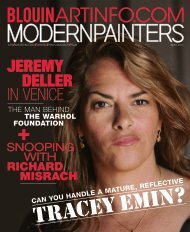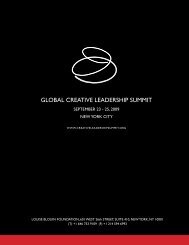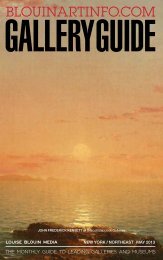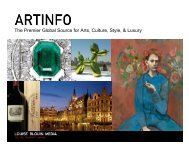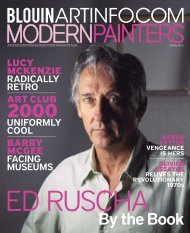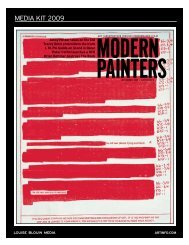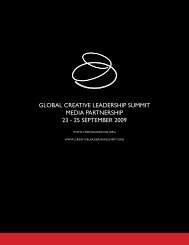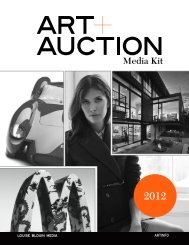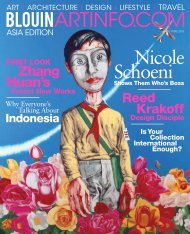Linke - Artinfo
Linke - Artinfo
Linke - Artinfo
You also want an ePaper? Increase the reach of your titles
YUMPU automatically turns print PDFs into web optimized ePapers that Google loves.
68<br />
Above:<br />
Gulammohammed<br />
Sheikh’s Speechless<br />
City, 1975, a 42-inchsquare<br />
oil on canvas.<br />
Opposite: The 2011<br />
inaugural exhibition<br />
at knmA in Saket,<br />
“Time Unfolded,”<br />
top, with Bharti kher’s<br />
The Skin Speaks a<br />
Language Not Its<br />
Own, 2006, a life-<br />
size fiberglass<br />
elephant covered<br />
in bindis, prominently<br />
displayed. Yatra,<br />
1955, below, is one<br />
of several works by<br />
m.F. Husain in the<br />
nadar collection.<br />
“Open Doors,” was curated by Karode. “The title had<br />
both a literal and a metaphoric sense, as knma opened its<br />
doors to the larger public to share Mrs. Nadar’s<br />
art collection, which was now placed in the public<br />
realm,” Karode explains. “Some rare works by Souza,<br />
Husain’s Mothers, 1990; Broota’s Runners, 1982; Bikash<br />
Bhattacharjee’s “Doll” series, 1971; A. Ramachandran’s<br />
Towards the Sun, 2004; N.S. Harsha’s Nations, 2007;<br />
and Gulammohammed Sheikh’s Speechless City, 1975,<br />
were all part of this exhibition, which introduced the<br />
collection to the art community and the general public.”<br />
But Noida proved an inconvenient location; Nadar’s<br />
mission of creating visual literacy through art and<br />
encouraging art appreciation among the general populace<br />
was difficult to achieve there. In January 2011 knma<br />
opened its second space at the mall in Saket with “Time<br />
Unfolded,” an expansive show curated by Karode that<br />
covered a range of modern and contemporary Indian<br />
expression, with special focus on the Bengal region as<br />
a hub of modernism in pre-independence India. The show<br />
highlighted work by the Progressives and included art<br />
by diaspora artists like Kapoor and Raqib Shaw. Among<br />
the more emblematic pieces was Gupta’s life-size fiberglass<br />
sculpture of an Indian family of four riding a Bajaj<br />
scooter, 2006, which has come to epitomize the country’s<br />
middle class in the 1970s and ’80s. The lavish opening<br />
coincided with the India Art Summit (now the India Art<br />
Fair) and brought together the biggest names from the<br />
country’s art world as well as figures from the inter-<br />
national circuit. The museum was hailed as India’s first<br />
philanthropic institution for modern and contemporary<br />
Indian art. “It’s a vision that India needs,” says Nadar.<br />
Meanwhile, programming continues at the Noida space,<br />
which hosted two exhibitions in 2012: “Cynical Love:<br />
Life in the Everyday,” a group show with a technological<br />
theme curated by Gayatri Sinha, and “Of Bodies, Armour<br />
and Cages,” a solo show of Shakuntala Kulkarni’s installations<br />
and photographs that address the relationship of<br />
the body to the dual notions of protection and entrapment,<br />
curated by Karode. “Zones of Contact,” organized by in-<br />
house curator Akansha Rastogi and guest curators Vidya<br />
Shivadas and Deeksha Nath, is the latest show to open<br />
in the Noida space and remains on view through September.<br />
The 2013 program at Saket promises to be a more<br />
ambitious affair, according to Karode. “At knma, we<br />
are showcasing the first comprehensive retrospective of<br />
Nasreen Mohamedi in India,” she says. The Karachi-born<br />
artist, who died in 1990, was known for her Mondrianinspired<br />
minimalism. The museum is simultaneously hosting<br />
(through November) two additional new shows, “Amrita<br />
Sher-Gil: Self in the Making,” co-curated by Karode<br />
and Vivan Sundaram, the artist’s nephew, and a third show<br />
curated by Karode, which features work by several artists.<br />
“The galleries are divided so that all three exhibitions<br />
coexist, and the entire 18,000 square feet is not used for just<br />
one exhibition as before,” says Karode.<br />
For all the intensive programming at both venues,<br />
Nadar isn’t satisfied. “The aim is to eventually build a<br />
museum,” she says. “I think the building of an iconic<br />
structure is as important for a museum as the art it houses.<br />
That’s the legacy that I’d like to leave.” Aside from tax<br />
exemptions, Nadar has received no governmental support<br />
for her initiatives. “Trying to get land or trying to get<br />
the government to see the importance of a museum is an<br />
uphill task,” she says. “All across the world, private<br />
museums are funded through a public-private partnership<br />
where land is normally granted. That is the kind of<br />
model we’d like to get into.”<br />
Nadar is currently seeking a 100,000-square-foot site<br />
for a new building that can house her growing collection,<br />
which she currently estimates at more than 500 works.<br />
As ambitious plans for expansion and longevity evolve,<br />
Nadar’s focus remains squarely on collecting works<br />
by India’s modern and contemporary artists. The sole<br />
exception is her recent acquisition of a Marina Abramović<br />
print, Artist Portrait with a Candle, 2012, which features<br />
the artist seated solemnly, garbed in black, candle in hand,<br />
its light shining on the backdrop like a halo.<br />
knma has set many precedents in India, with its state-<br />
of-the-art conservation practices and clarity of mission,<br />
particularly impressive as the National Gallery of<br />
Modern Art (the only state-run institution for modern<br />
and contemporary art) founders without a coherent<br />
acquisitions policy. Another precedent is its vision of the<br />
museum as a hub for conversation between artists in<br />
the presence of artworks and for interventions by artists<br />
such as Sonia Khurana and Zuleikha Chaudhari, who<br />
have reimagined the museum space through performance<br />
and interactive installations. In just three years Nadar has<br />
established an institution recognized for the quality of its<br />
holdings and respected as the place where works that have<br />
been in exile, like Saurashtra, will find a permanent home.<br />
March/april 2013 | Blouin<strong>Artinfo</strong>.comAsiA<br />
this page and opposite: knma<br />
“a public-private<br />
partnership<br />
is the kind<br />
of model<br />
we’d like<br />
to get into.”<br />
Blouin<strong>Artinfo</strong>.comAsiA | march/april 2013<br />
67




